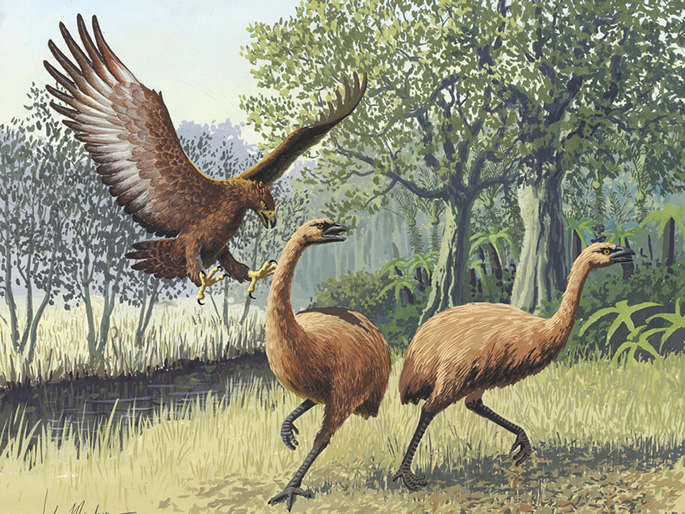
Giant Haasts eagle attacking New Zealand moa
“In general, the heavier an animal species is, the lower its population density (the numbers of a species that can be supported in an area of land)” Latham said. “This is because larger animals need more energy resources (food/water) to survive. This relationship is strong for living species of flightless birds and therefore it can be used to estimate densities of extinct species of flightless birds”.
The authors compiled a global data set of body masses and population densities for living flightless birds and examined the statistical relationship between these variables, controlling for the effects of limiting factors such as the suitability of the habitat where populations occur and whether densities have been artificially reduced, e.g. by introduced predators or human disturbance.
They then applied this approach to extinct species by estimating population densities and population sizes for each of the nine species of moa (Dinornithiformes) to build up a picture of total moa density across New Zealand about 1,000 years ago (i.e. before human arrival).
“We calculated a mean national density of moa ranging between two (a low-density scenario) and 10 birds per square km (a high‐density scenario) – to give a total estimated population of between 0.5 and 2.5 million birds.” study co-author Jamie Wood said. “These estimates reconcile previous population density estimates for moa, which have been either quite low (fewer than two per square km) or high (more than 10 per square km).”
While these new estimates are broadly similar to contemporary densities of large herbivorous wild mammals (such as deer) introduced into New Zealand about 150 years ago, the authors point out that “similar densities do not mean similar impacts, as many other factors affect the way large herbivores affect their environments”.
It is hoped that the refined model can also allow improved population density estimates for other large prehistoric flightless birds around the world, such as the elephant birds from Madagascar, the Mauritian dodo, or the Hawaiian moa‐nalos. “Population sizes and densities are important aspects of the ecology of extinct species, but are often overlooked because they are difficult to estimate,” Latham said, “but such data are key, not only for understanding the roles these species once played within their ecosystems, but also in understanding the processes that ultimately led to their extinction.”

